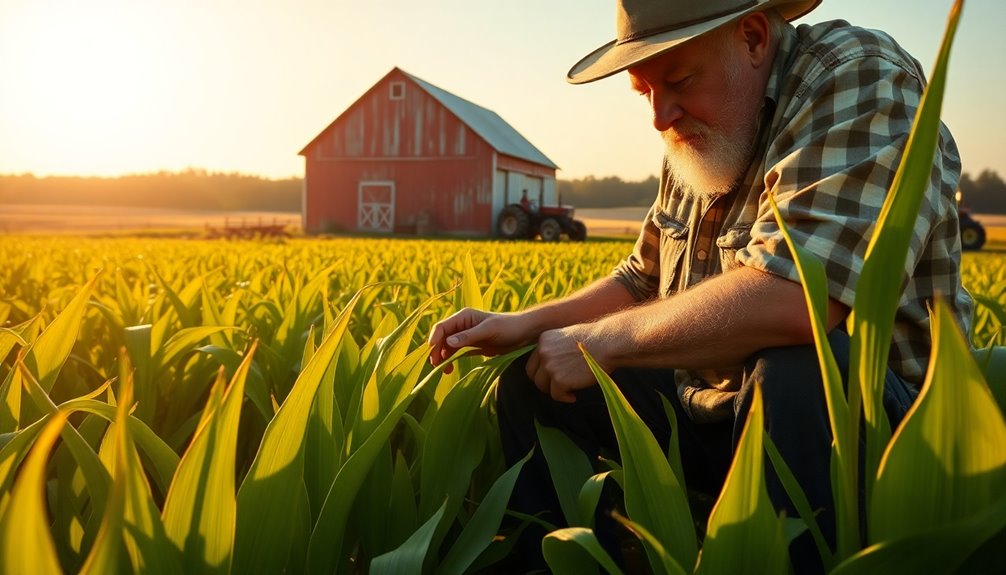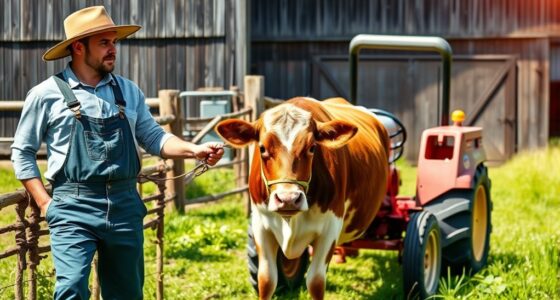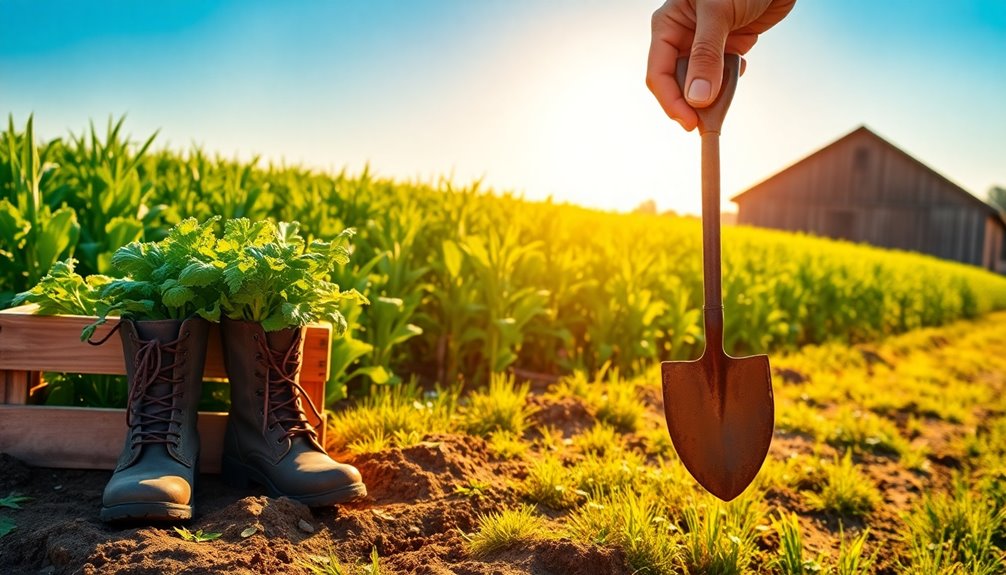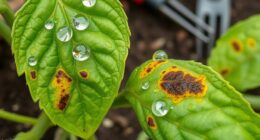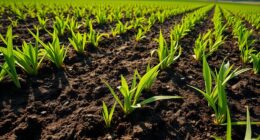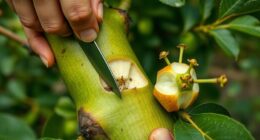Farming means cultivating the land and raising animals for food, fiber, and other products. It's an essential practice, employing over a billion people and generating around $1.3 trillion annually. You should know that farming affects about half of Earth's habitable land, influencing both resource management and biodiversity. While it offers economic benefits, there are environmental challenges, like water consumption and habitat loss. Sustainable practices and technological innovations are shaping the future of agriculture. Understanding these elements can help you grasp the full picture of farming's role in our world, including its potential for a balanced ecosystem and food security.
Key Takeaways
- Farming involves cultivating soil and raising animals primarily for food, fiber, and other products, categorized into subsistence and commercial practices.
- It employs over 1 billion people globally and represents the largest industry, generating approximately $1.3 trillion in food production annually.
- Agriculture occupies about 50% of Earth's habitable land, influencing resource management and land use significantly.
- Farming faces environmental challenges, including freshwater consumption, habitat loss, and greenhouse gas emissions, necessitating sustainable practices.
- Technological innovations, such as precision agriculture and genetic modification, are essential for enhancing productivity while minimizing environmental impact.
Definition of Farming
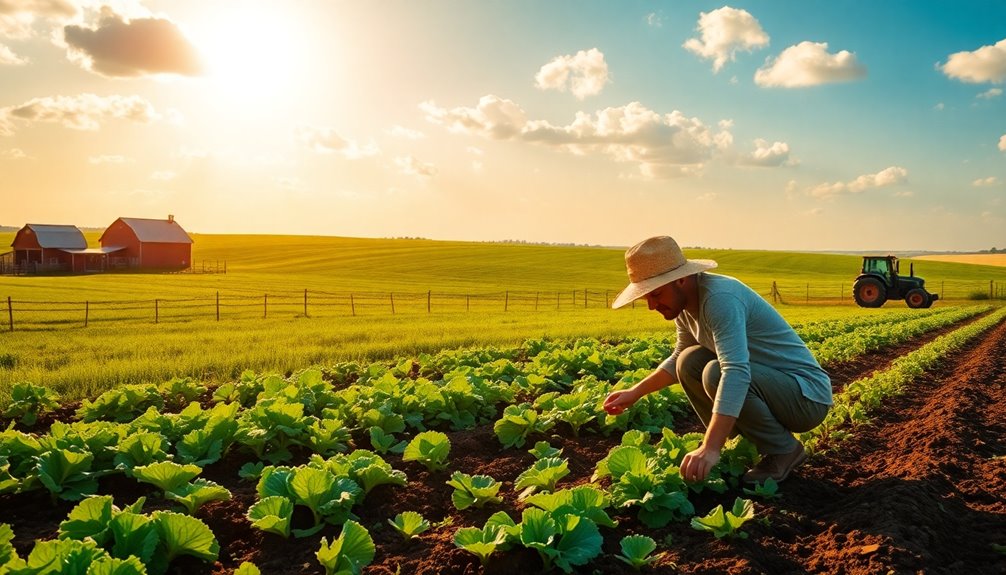
Farming, at its core, is the essential practice of cultivating soil and raising animals to produce food, fiber, and other products that sustain human life.
It includes various farming practices, such as subsistence farming, which focuses on meeting the needs of the farmer's family, and commercial farming, aimed at maximizing agricultural production for profit.
By employing over 1 billion people, farming plays a vital role in the global economy, generating around $1.3 trillion in food each year.
The industry also greatly impacts land use, with pasture and cropland covering about 50% of Earth's habitable land.
As we face growing environmental concerns, sustainable farming practices are becoming increasingly important to guarantee food security while preserving biodiversity for future generations.
Importance of Agriculture

Agriculture plays a crucial role in shaping economies and communities worldwide. It's the largest global industry, employing over 1 billion people and generating around $1.3 trillion in food production annually. This impact helps lower property taxes and supports local economies. Sustainable agricultural practices are essential for enhancing community aesthetics and maintaining open spaces, which also recharge groundwater and support biodiversity. With approximately 50% of Earth's habitable land dedicated to pasture and cropland, understanding land use is fundamental for resource management. Here's a quick overview of agriculture's importance:
| Aspect | Impact | Importance |
|---|---|---|
| Employment | Over 1 billion people | Economic stability |
| Food Production | $1.3 trillion annually | Food security |
| Local Economy | Generates revenue for local governments | Lowers property taxes |
| Community Aesthetics | Maintains open spaces | Enhances living environments |
| Land Use | 50% of habitable land used | Resource management |
Environmental Impact of Farming
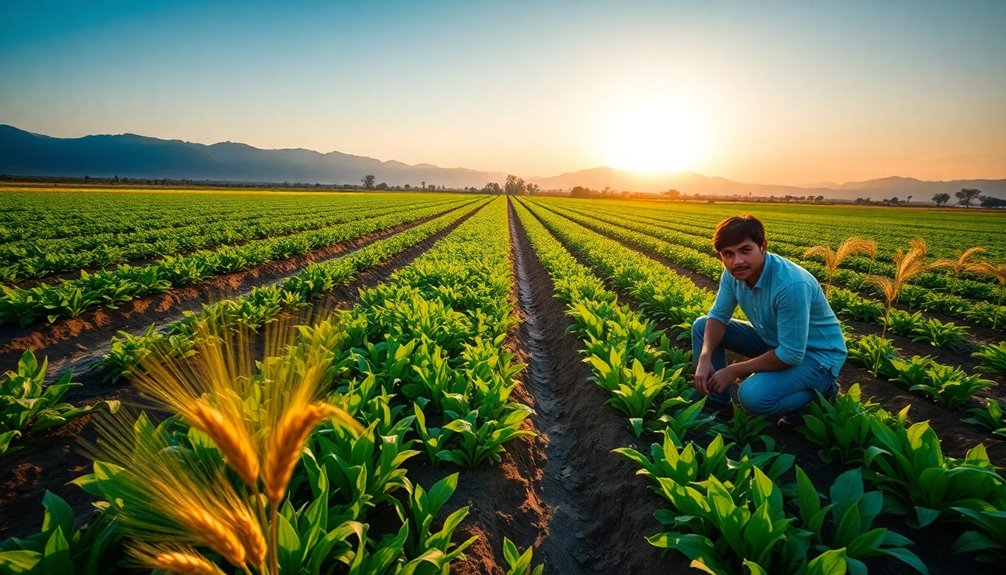
The environmental impact of farming is profound and multifaceted, affecting everything from water resources to biodiversity. Your agricultural practices considerably contribute to environmental degradation, accounting for about 69% of global freshwater consumption and driving habitat loss through deforestation.
The use of fertilizers and pesticides leads to nutrient runoff, causing eutrophication in aquatic ecosystems, which creates dead zones where marine life can't survive. Unsustainable farming methods have resulted in severe soil erosion, with half of the world's topsoil lost in the past 150 years.
Additionally, livestock farming emits substantial greenhouse gases like methane, which has a much higher global warming potential than carbon dioxide. Overall, farming's extensive ecological footprint threatens biodiversity and ecosystem services essential for a healthy planet.
Sustainable Agricultural Practices
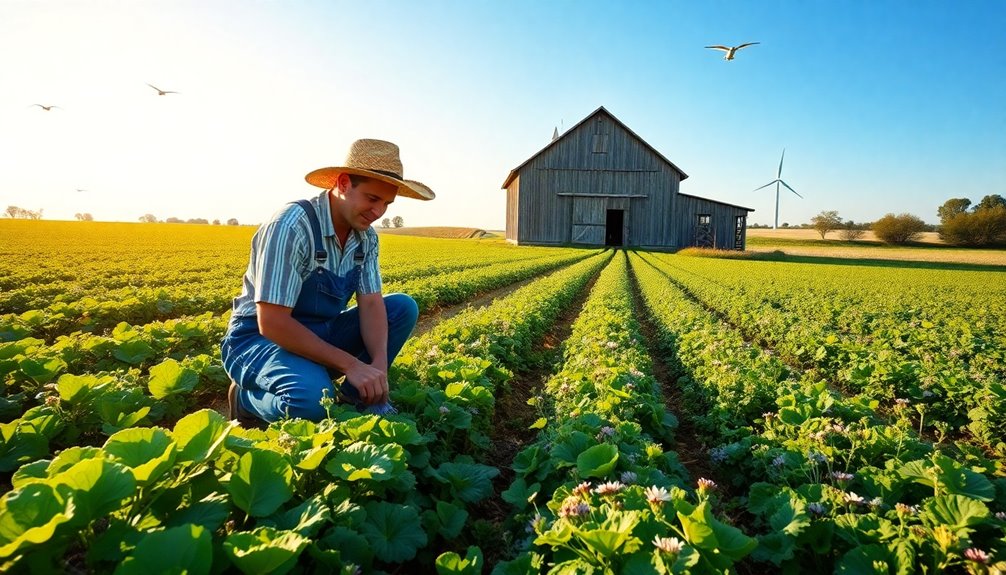
Recognizing the significant environmental challenges posed by traditional farming methods opens the door to sustainable agricultural practices that prioritize ecological balance.
These practices not only enhance environmental health but also guarantee food security for future generations. By embracing sustainable methods, you can help combat environmental degradation and foster resilient farming systems.
Here are three key sustainable agricultural practices to evaluate:
- Crop rotation – This helps maintain soil fertility and reduce pest outbreaks.
- Organic farming – Minimizing synthetic inputs improves soil health and biodiversity.
- Reduced pesticide use – This protects critical habitats and supports beneficial organisms.
Transitioning to these approaches empowers you to contribute to a healthier planet while supporting local economies.
Let's work towards a sustainable future together!
Good Agricultural Practices Overview

In today's agricultural landscape, Good Agricultural Practices (GAP) play an essential role in ensuring the quality and safety of crops and livestock. By adhering to GAP, you can enhance your agricultural operations, maximizing yields while optimizing production practices.
Third-party audits conducted by the USDA verify compliance with FDA guidelines, ensuring you meet recognized safety and quality standards. Regular audits empower you and your workers, improving processes and fostering a culture of continuous improvement.
Utilizing mobile-friendly audit verification checklists allows you to tailor practices to your specific needs, making compliance more manageable. Ultimately, implementing GAP helps minimize environmental impact, securing a sustainable supply of quality products for consumers while reducing operational costs.
Economic Aspects of Farming

When you think about farming, consider how it drives profitability and revenue generation.
The balance of market demand and supply plays a vital role in determining what crops thrive and how farmers invest their resources.
Understanding these economic aspects is key to grasping the bigger picture of agriculture's impact on communities and economies.
Profitability and Revenue Generation
Farming plays an essential role in generating significant revenue and ensuring economic stability. By engaging in agricultural activities, you contribute to an industry that generates approximately $1.3 trillion annually.
Here are three ways farming enhances profitability and revenue generation:
- Specialization: Many commercial farms focus on a limited number of commodities, which boosts economies of scale and increases profitability.
- Local Employment: Agricultural activities provide primary livelihoods for individuals in rural areas, supporting community economic stability.
- Support for Agribusiness: The agricultural sector not only thrives but also supports related industries like supply, processing, and distribution, fostering overall economic growth.
Market Demand and Supply
Market dynamics in agriculture are shaped by consumer preferences and the seasonal availability of crops, directly impacting prices and farm income.
Understanding market demand is essential for you as a farmer because it influences what crops to cultivate. For instance, staple crops like rice and wheat have inelastic demand, meaning their prices are stable despite changes in supply. In contrast, luxury items like organic produce can see significant price fluctuations based on consumer interest.
Efficient supply chains are important; they guarantee that food production reaches consumers quickly, aligning with market demand. Surplus production can lead to lower prices, causing financial strain, particularly in developing countries.
Consequently, balancing supply and demand is fundamental for maintaining a sustainable agricultural business.
Investment and Resource Allocation
Understanding market demand and supply lays the groundwork for addressing investment and resource allocation in agriculture. To thrive, you must consider the following aspects:
- Sustainable Practices: Investing in sustainable agricultural methods not only boosts productivity but also minimizes environmental impacts.
- Access to Resources: Ensuring small-scale farmers have access to essential resources and capital is critical for their competitiveness in the market.
- Economic Viability: Supporting policies that enhance investment can lead to long-term economic stability, benefiting local economies and lowering property taxes.
Social and Cultural Impacts
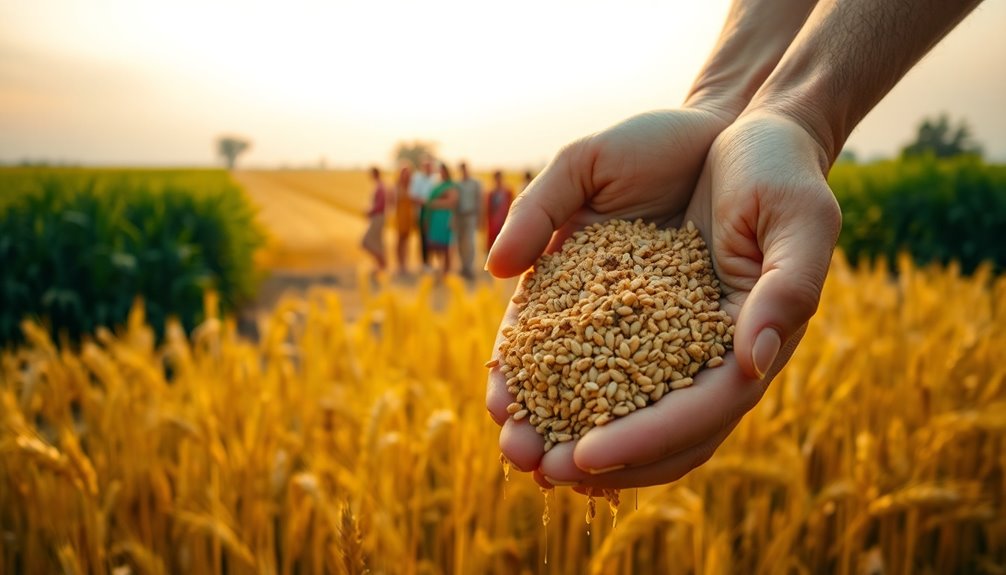
Agriculture plays an essential role in shaping social and cultural dynamics within communities. Through farming practices and traditions passed down generations, you'll find a strong sense of belonging and cultural heritage.
In places like Pennsylvania, agriculture not only boosts the economy but also enhances community aesthetics with beautiful open spaces and scenic landscapes that everyone appreciates. Local food systems thrive on these practices, promoting food security and access to fresh produce, which supports health and wellbeing.
The presence of farms opens doors to agritourism and farm-to-table experiences, enriching local culture. Additionally, agricultural activities create social networks among farmers and community members, fostering collaboration and strengthening community ties.
Moreover, the presence of farmers can foster resilience in families, as they navigate challenges similar to those faced by families dealing with divorce.
Your connection to farming can truly enhance the community spirit around you.
Innovations in Agriculture
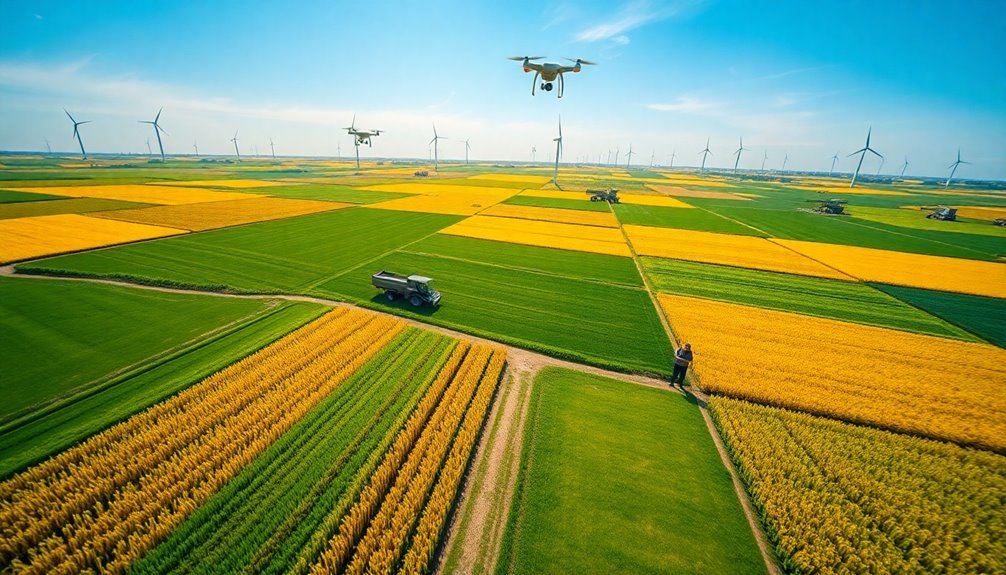
Innovative farming techniques are transforming the agricultural landscape, making it more efficient and sustainable.
These innovations are essential for maximizing productivity while protecting our agricultural land.
Here are three notable advancements:
- Precision Agriculture: Utilizing GPS and data analytics, it optimizes field-level management, leading to better yields and less resource waste.
- Robotic Milking Systems: Automating the milking process enhances efficiency and improves animal welfare, resulting in higher productivity.
- Genetic Modification (GMOs): Developing crops with resistance to pests and diseases boosts food security and reduces dependence on chemical pesticides.
Challenges Facing Farmers

Farming today is fraught with challenges that threaten the livelihoods of many producers. Climate change brings increased weather variability, impacting your crops and livestock due to droughts, floods, and shifting growing seasons.
The rising costs of seeds, fertilizers, and fuel put a financial strain on you, with profit margins often dipping below 10% after expenses. Access to water is another critical issue, as overpumping threatens long-term sustainability, especially in drought-prone regions.
Small-scale farmers like you struggle with limited access to markets and resources, often competing against large industrial farms that benefit from economies of scale. Additionally, pests and diseases are becoming resistant to conventional treatments, pushing you toward costly, innovative pest management strategies.
Future of Agricultural Practices
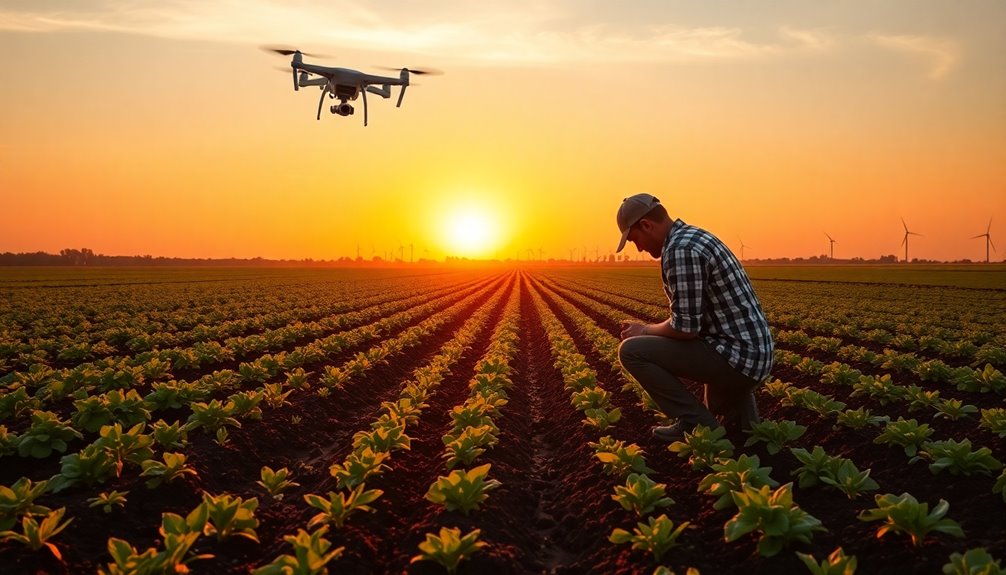
As you look ahead, the future of agricultural practices centers on sustainability and innovation.
You'll see technology playing a vital role, from precision farming that maximizes efficiency to advancements in crop resilience through genetic engineering.
This shift not only addresses food needs for a growing population but also aligns with consumer demand for healthier, environmentally friendly options.
Sustainable Innovations in Agriculture
Sustainability in agriculture is more than just a trend; it's a necessary evolution for the future of food production.
You can embrace sustainable innovations that enhance productivity while minimizing environmental impact. Here are three key practices to take into account:
- Crop Rotation: This helps maintain soil health and biodiversity, reducing the need for chemical fertilizers.
- Water Conservation Techniques: With farming consuming 69% of freshwater, efficient methods are essential in addressing water scarcity.
- Community-Supported Agriculture (CSA): By supporting local markets, you engage with sustainable practices that enhance food security and reduce transport emissions.
Technology's Role in Farming
Modern agriculture is rapidly transforming with the integration of technology, reshaping how farmers approach food production.
Techniques like precision agriculture use GPS and data analytics to increase efficiency by up to 20%, optimizing crop yields while minimizing resource waste.
The Green Revolution introduced high-yield crops and advanced irrigation, greatly boosting food production and saving billions from starvation.
Robotic milking systems enhance dairy farming, producing 10% more milk while improving animal welfare.
Drones and satellite imagery help you monitor crops in real-time, identifying pest issues and irrigation needs.
Additionally, biotechnology, including GMOs, aims to create pest-resistant crops, potentially increasing agricultural output by 30% and reducing chemical use.
Embracing these technologies is essential for the future of agriculture. Furthermore, adopting energy-efficient technologies can also contribute to sustainable farming practices and reduce operational costs.
Frequently Asked Questions
What Is the Definition of Farming Practices?
Farming practices refer to the methods you use for cultivating crops and raising livestock. They include techniques like soil management, crop rotation, and pest control.
You might engage in subsistence agriculture, growing food mainly for your own needs, or commercial agriculture, focusing on producing goods for sale.
Sustainable practices are essential too, allowing you to enhance productivity while protecting the environment.
What Is the Full Meaning of Farming?
When you think of farming, imagine the age-old dance between humans and nature, like a symphony of growth.
Farming's full meaning encompasses the cultivation of soil, raising livestock, and producing food and goods. It's not just about planting seeds; it's about nurturing life and sustaining communities.
Whether you're growing crops or tending animals, farming reflects our connection to the earth and our responsibility to guarantee its health for future generations.
What Are the 3 Main Components of Agriculture?
The three main components of agriculture are crop production, livestock raising, and agroforestry.
When you focus on crop production, you're cultivating plants for food and other uses, taking up about 75% of agricultural land.
If you raise livestock, you manage animals for products like meat and milk, but be mindful of their environmental impact.
Finally, integrating trees through agroforestry helps enhance biodiversity and soil health, providing additional income for you as a farmer.
Does Agriculture Include Farming?
Yes, agriculture does include farming.
When you think about agriculture, you're looking at a broader picture that encompasses various practices. Farming is the core component where you cultivate crops and raise livestock.
It's crucial to recognize that agriculture also involves processing, distributing, and marketing these products.
Conclusion
In understanding farming, you grasp not just the act of planting seeds but the pulse of life that nourishes communities. You see the balance between cultivating crops and conserving nature, between embracing innovation and honoring tradition. You recognize the challenges farmers face and the resilience they embody. As you look to the future, remember that farming is more than an occupation; it's a way of life that shapes our world, sustains our bodies, and connects us all.

